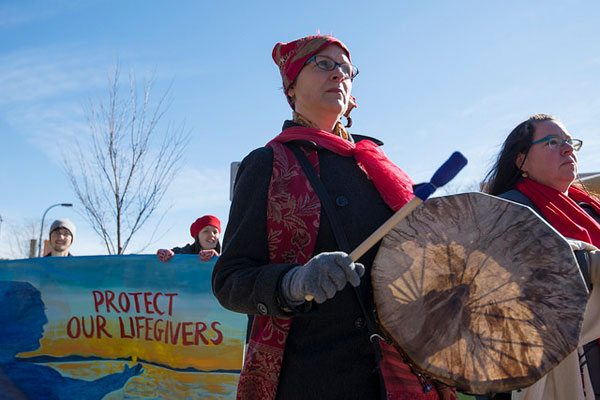
January 5, 2018, LastRealIndians.com
US authorities gather missing person statistics for every demographic except for Native American women. Even lacking accurate real-time data, we know that indigenous women have the highest rates of rape and assault. A flawed tribal court structure, little local law enforcement, and a lack of funding fail to protect indigenous women from violence.
In Seattle, 380 people (and 3,200 interested onlookers) have stated their intent on Facebook to join Missing & Murdered Indigenous Women Washington (MMIWW) as they lead the second Seattle Women’s March on Saturday, January 20th, from 10:00 AM to 3:00 PM PST. MMIWW participants will also join the Women’s March in Olympia, Washington on Saturday. Over 250 marches, rallies, and actions are planned for the “Weekend of Women” as part of the anniversary of the 2017 Women’s March, the largest single-day protest in American history.
Our mission is to raise consciousness, unite and demand action for Indigenous women, girls, Two Spirit and LGBTQ people who have been murdered or gone missing, tortured, raped, trafficked, and assaulted, who have not had the proper attention or justice. All too often, we see the tragedies in our communities happening at horrendous rates. Many factors contribute to the disproportionate number of Indigenous women who are missing and murdered throughout the Americas.
According to a 2016 U.S. Department of Justice report analyzing the findings of a 2010 study conducted by the National Institute of Justice, more than four in five American Indian and Alaska Native women (84.3 percent) have experienced violence in their lifetime, including:
Sign up for our free newsletters
Subscribe to NPQ's newsletters to have our top stories delivered directly to your inbox.
By signing up, you agree to our privacy policy and terms of use, and to receive messages from NPQ and our partners.
- 1 percent who have experienced sexual violence.
- 5 percent who have experienced physical violence by an intimate partner.
- 8 percent who have experienced stalking.
- 4 percent who have experienced psychological aggression by an intimate partner.
- Overall, more than 1.5 million American Indian and Alaska Native women have experienced violence in their lifetime.
- More than 1 in 3 American Indian and Alaska Native women (39.8 percent) have experienced violence in the past year.
This report also speaks to the nation’s indifference to the dangerous forces that prey on indigenous women:
Few estimates are available to describe the prevalence of violence against American Indian and Alaska Native women and men. In addition, these estimates are often based on local rather than national samples (e.g., Yuan et al., 2006; Wood and Magen, 2009). The few available national estimates are often based on very small samples. These small samples do not always accurately represent the American Indian and Alaska Native population in the United States (Crossland et al., 2013).
MMIW and other indigenous activists have been organizing protests and vigils for many years. First Nations organized the first Women’s Memorial March in Vancouver in 1992. Today, this event takes place annually on Valentine’s Day in more than 22 communities across North America. The landscape for indigenous women remains harshly indifferent, reducing almost everything to survival. For them and their loved ones, America is an increasingly bleak place that ends not even in turmoil but bitter silence. But not for MMIW:
This year we take to the streets for our MMIW Mothers, Sisters, Grandmothers, Aunties, Cousins and loved ones in their memory and honor. We want to thank the Women’s March Org for honoring and supporting Missing and Murdered Indigenous Women Washington.
—Jim Schaffer













